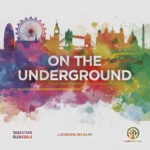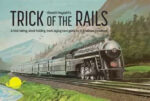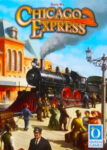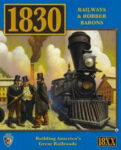A little look behind the curtain, I have been working on this list since April 1, 2021, slowly updating items and adjusting the list as I played favorites more and got some different ones to the table. And to be honest, I am so happy that I waited this long to publish it. Because when I started, I was deep into train games. But now, I have sunk into the abyss that is the train game rabbit hole. When looking at my total plays for 2022, 53 percent of them have been train games (thanks to the Dads on a Map community for the help).
Train gaming itself is a fairly niche genre, with the majority of the ones I’m mentioning having under ten thousand owned copies registered on BoardGameGeek. There’s some debate on what a train game is as well. Most would consider any game with a train theme to be a train game (Ticket to Ride, Railroad Ink, and Russian Railways being quite popular examples of train-themed games).
Others that have explored the genre more would say that train games require some amount of shared incentives to fall into the category. Basically, if someone takes an action, can players benefit or face drawbacks to their decision more than just blocking. An example would be through the payouts a lot of economic games feature. If Player A and Player B are both invested in a company, then they both receive the benefits of a dividend payout. Player A can also decide they no longer want to make positive plays for that company, which in turn hurts Player B. This is a key feature to nearly all the games on my list.
There are a couple of asterisks to mention. I’m only featuring published games on my list, but not all of my favorites have been published. For starters, Drew Edwards has designed the fantastic two-player Streetcar Suburb. Very few train games are recommended at two, so Drew’s game fills that hole while featuring some aspects of city planning. Also worth mentioning on the unpublished side is The Old Prince 1871, which features so many cool innovations that it would take a full paragraph or two to mention them all. It is available on 18xx.games to try out.
But enough of the preamble. Grab your tickets, wait for the horn, and enjoy your entertainment.
Top 10 Train Board Games
10. On the Underground: London/Berlin
 This one surprised me. While it had a reprint in 2019, On the Underground really wasn’t on my radar. But it does some things that are unique, even though some of the game is similar to others. It has route building similar to Splotter’s Bus, where you can only extend your line from either end once the initial piece is placed. The kicker that separates it from nearly all other train games is that you have multiple subway lines you are building that can work alone, with your other colors, or even with your opponents’ routes. There is pick up and deliver, a common mechanic among train games, but On the Underground features one lowly passenger who will do whatever they can to not swap lines and not have to walk to their destination. There are also ways to earn points just from building track onto certain icons printed on the board. On the Underground makes the list based on feeling different from the pack. It’s not an economic game, but a route management game, which is fun in its own right.
This one surprised me. While it had a reprint in 2019, On the Underground really wasn’t on my radar. But it does some things that are unique, even though some of the game is similar to others. It has route building similar to Splotter’s Bus, where you can only extend your line from either end once the initial piece is placed. The kicker that separates it from nearly all other train games is that you have multiple subway lines you are building that can work alone, with your other colors, or even with your opponents’ routes. There is pick up and deliver, a common mechanic among train games, but On the Underground features one lowly passenger who will do whatever they can to not swap lines and not have to walk to their destination. There are also ways to earn points just from building track onto certain icons printed on the board. On the Underground makes the list based on feeling different from the pack. It’s not an economic game, but a route management game, which is fun in its own right.
2-5 Players • Ages 14+ • 46-60 minutes • $40
9. Trick of the Rails
 Talk about the weirdest game on the list, the core mechanism that makes Trick of the Rails distinct is also in the name: trick taking. In practice, it shouldn’t work for either the train gamer or the trick taking fan. But what Trick of the Rails does is make what you play, even if you aren’t going to win the trick, incredibly consequential. Like 18xx games, you alternate between stock acquiring and track laying, but using trick taking as the core for both. During stock rounds, the winner of the trick takes the card from the trick lane (a line of cards that acts as the game timer and moves players through each round) as a share, while players who didn’t win still add their played card as a share. During track laying, a city or locomotive is added to any company by the winner of the trick (cities being a huge source of points), while the others add their played cards to the line of the respective color companies. It’s such an odd blend that works, as every single card play is important to the extension of companies or gaining a share in the most valuable railroad. It is one of the thinkiest trick taking games I have played.
Talk about the weirdest game on the list, the core mechanism that makes Trick of the Rails distinct is also in the name: trick taking. In practice, it shouldn’t work for either the train gamer or the trick taking fan. But what Trick of the Rails does is make what you play, even if you aren’t going to win the trick, incredibly consequential. Like 18xx games, you alternate between stock acquiring and track laying, but using trick taking as the core for both. During stock rounds, the winner of the trick takes the card from the trick lane (a line of cards that acts as the game timer and moves players through each round) as a share, while players who didn’t win still add their played card as a share. During track laying, a city or locomotive is added to any company by the winner of the trick (cities being a huge source of points), while the others add their played cards to the line of the respective color companies. It’s such an odd blend that works, as every single card play is important to the extension of companies or gaining a share in the most valuable railroad. It is one of the thinkiest trick taking games I have played.
3-5 Players • Ages 10+ • 20 minutes • Out of Print
8. Northern Pacific
 This one surprises me. It’s so basic in premise, with the big hook being an emphasis on short-term alliances. On a turn, you place an investment cube (either small or large cube) in a city or extend the train. When the train reaches a city with cubes in it, all players with colors of cubes in that city get a “payout” of their cubes from the supply (one for small cubes, two for big cubes) A round ends when the train reaches Seattle and with the number of cubes a player has in front of them as their score. Play three rounds and the most points wins. But here’s the depth. Like other good train games, moves revolve around teaming up with a player by placing your cube in a city with theirs. You exchange high fives, as their next turn they move their cube into your city. But what if a player is in between you and your “partner.” Will they join in on the fun you two are having? Or will they use their turn to send the train the opposite way, leaving your cubes on the board? Those decisions, while light, are incredibly fun and annoyingly mean in the best ways.
This one surprises me. It’s so basic in premise, with the big hook being an emphasis on short-term alliances. On a turn, you place an investment cube (either small or large cube) in a city or extend the train. When the train reaches a city with cubes in it, all players with colors of cubes in that city get a “payout” of their cubes from the supply (one for small cubes, two for big cubes) A round ends when the train reaches Seattle and with the number of cubes a player has in front of them as their score. Play three rounds and the most points wins. But here’s the depth. Like other good train games, moves revolve around teaming up with a player by placing your cube in a city with theirs. You exchange high fives, as their next turn they move their cube into your city. But what if a player is in between you and your “partner.” Will they join in on the fun you two are having? Or will they use their turn to send the train the opposite way, leaving your cubes on the board? Those decisions, while light, are incredibly fun and annoyingly mean in the best ways.
3-6 Players • Ages 7+ • 60 minutes • $35
7. Stephenson’s Rocket
 Had you asked me even 6 months ago what I thought of Reiner Knizia’s take on the train game, I would have said it was bad. But with a recent play of it, my thoughts on it have completely reversed. That being said, it’s not the most intuitive to teach or understand on the first play. And the Ian O’toole graphic design in the most recent printing doesn’t help that either. But what you have here is the “take two actions” you’d expect from Knizia, but with a couple of competing ways to score and a huge focus on merging train companies. Oh, and when someone moves a train that you have shares in, you can attempt to veto that move by calling for a once-around auction. And if you pay more than the active player, you can just change the direction that the train moves. It’s quite opaque, so you’ll need at least one trial round to get your bearings. But it’s one that’s worth exploring after getting over the initial hump.
Had you asked me even 6 months ago what I thought of Reiner Knizia’s take on the train game, I would have said it was bad. But with a recent play of it, my thoughts on it have completely reversed. That being said, it’s not the most intuitive to teach or understand on the first play. And the Ian O’toole graphic design in the most recent printing doesn’t help that either. But what you have here is the “take two actions” you’d expect from Knizia, but with a couple of competing ways to score and a huge focus on merging train companies. Oh, and when someone moves a train that you have shares in, you can attempt to veto that move by calling for a once-around auction. And if you pay more than the active player, you can just change the direction that the train moves. It’s quite opaque, so you’ll need at least one trial round to get your bearings. But it’s one that’s worth exploring after getting over the initial hump.
2-4 Players • Ages 12+ • 60 minutes • $55
6. 1870: Railroading Across the Trans Mississippi from 1870
 I’ve sung the praises of all the games so far, but I’ll start with a downer for 1870. It’s long, and while I plan on getting a copy, my preferred method of playing is async on 18xx.games. That being said, it is a natural progression from the 1830 style of game. The private companies are really interesting and fun to strategize around. The board may be big, but it can produce really rude track laying that makes gaining money super difficult. The introduction of price protection makes selling shares a risk, as it could hand a president a huge amount of money. These are really cool to explore after playing a lot of 1830 and its derivatives. But it’s still really long, so that is a factor of why it isn’t higher.
I’ve sung the praises of all the games so far, but I’ll start with a downer for 1870. It’s long, and while I plan on getting a copy, my preferred method of playing is async on 18xx.games. That being said, it is a natural progression from the 1830 style of game. The private companies are really interesting and fun to strategize around. The board may be big, but it can produce really rude track laying that makes gaining money super difficult. The introduction of price protection makes selling shares a risk, as it could hand a president a huge amount of money. These are really cool to explore after playing a lot of 1830 and its derivatives. But it’s still really long, so that is a factor of why it isn’t higher.
2-6 Players • Ages 14+ • 360 minutes • Out of Print
5. Age of Steam
 One of the most expandable games ever designed (ignoring the majority of CCGs), Age of Steams takes a barebones approach to the train genre on the rules side. There are a set number of rounds and turns follow the same structure with little variance from round to round. Players auction for actions, they take turns building track, they deliver at most two goods a piece, and finally, they earn income or pay for expenses. Where the game gets its variability is the sheer number of maps. Some are minor changes that only adjust the geography. Some adjust some of the action choices available during the auction for thematic purposes. And others, like the Moon, Human Body, or Disco Inferno, turn the game on its head so much you feel like you’re playing a different game with each variation.
One of the most expandable games ever designed (ignoring the majority of CCGs), Age of Steams takes a barebones approach to the train genre on the rules side. There are a set number of rounds and turns follow the same structure with little variance from round to round. Players auction for actions, they take turns building track, they deliver at most two goods a piece, and finally, they earn income or pay for expenses. Where the game gets its variability is the sheer number of maps. Some are minor changes that only adjust the geography. Some adjust some of the action choices available during the auction for thematic purposes. And others, like the Moon, Human Body, or Disco Inferno, turn the game on its head so much you feel like you’re playing a different game with each variation.
1-6 Players • Ages 13+ • 120 minutes • $120
4. TransAmerica
 It may be one of the lightest games and fastest on the list, but TransAmerica introduces that major concept common to the majority of train games I mentioned earlier: shared incentives. Each player has five US cities in five sections of the country, and they must connect all five first. But all of the track is one color, meaning once my section of track meets up with my opponents’, then it becomes track that I can extend off of. That means all the hard work you did may end up being the tracks I need to win on my next turn. Of all the train games on my list, it’s the one that produces the most excitement. When a player proclaims “I’m finished,” the rest of the table wants to toss their cards and shout in anger. And if you add in the Vexation micro-expansion, the game gets even better and meaner, adding three tracks that are exclusive to you when placed. It’s a light one for certain, but it’s been a hit every time I’ve put it on the table. And for those that live outside of the US, there are versions based around Europe and Japan as well.
It may be one of the lightest games and fastest on the list, but TransAmerica introduces that major concept common to the majority of train games I mentioned earlier: shared incentives. Each player has five US cities in five sections of the country, and they must connect all five first. But all of the track is one color, meaning once my section of track meets up with my opponents’, then it becomes track that I can extend off of. That means all the hard work you did may end up being the tracks I need to win on my next turn. Of all the train games on my list, it’s the one that produces the most excitement. When a player proclaims “I’m finished,” the rest of the table wants to toss their cards and shout in anger. And if you add in the Vexation micro-expansion, the game gets even better and meaner, adding three tracks that are exclusive to you when placed. It’s a light one for certain, but it’s been a hit every time I’ve put it on the table. And for those that live outside of the US, there are versions based around Europe and Japan as well.
2-6 Players • Ages 13+ • 30 minutes • $30
3. Gulf, Mobile, and Ohio
 Lots of train games feature auctions, whether up front to distribute companies or to gain ownership of shares and put personal money into a company’s treasury. Of the games I’m featuring, none of them put the emphasis on auctions more than Gulf, Mobile, and Ohio. Half of the possible actions pertain to auctions, so if that’s not a mechanism you tend to enjoy, then you aren’t gonna like this game. But compared to other train games, this also does quite a few things different from the rest of the genre. The color cubes to build lines are not connected to a singular company, meaning that new companies that start cannot connect to already-built lines of that color. Similar to Age of Steam, money is a tool to score points instead of being the points themselves. All in all, this is a very cool game that stands apart for the other cube rails games.
Lots of train games feature auctions, whether up front to distribute companies or to gain ownership of shares and put personal money into a company’s treasury. Of the games I’m featuring, none of them put the emphasis on auctions more than Gulf, Mobile, and Ohio. Half of the possible actions pertain to auctions, so if that’s not a mechanism you tend to enjoy, then you aren’t gonna like this game. But compared to other train games, this also does quite a few things different from the rest of the genre. The color cubes to build lines are not connected to a singular company, meaning that new companies that start cannot connect to already-built lines of that color. Similar to Age of Steam, money is a tool to score points instead of being the points themselves. All in all, this is a very cool game that stands apart for the other cube rails games.
3-5 Players • Ages 12+ • 45-60 minutes • $30
2. Chicago Express
 An outstanding starting point for train games in general, Chicago Express tends to lead the charge on the cube rails side of things. Why? The action selection is simple, but innovative in that it uses dials with a limited number of actions that can be taken of a type in a round. And not only that, a player can choose an action, only to skip taking it and still move the dial down. Watching the table groan as you null an auction and you’re the player that benefits from it most is oh so satisfying. It’s a good intro to the idea that player money and company money are separate. It has gameplay that is simple enough to teach most anyone, but can be played at a high level. The Queen box size is a meme at this point, with some joking it could have its own gravitational force. But it’s very worth the shelf space as even with the static starting spaces for companies, the game has many difficult decisions, even when it’s not your turn.
An outstanding starting point for train games in general, Chicago Express tends to lead the charge on the cube rails side of things. Why? The action selection is simple, but innovative in that it uses dials with a limited number of actions that can be taken of a type in a round. And not only that, a player can choose an action, only to skip taking it and still move the dial down. Watching the table groan as you null an auction and you’re the player that benefits from it most is oh so satisfying. It’s a good intro to the idea that player money and company money are separate. It has gameplay that is simple enough to teach most anyone, but can be played at a high level. The Queen box size is a meme at this point, with some joking it could have its own gravitational force. But it’s very worth the shelf space as even with the static starting spaces for companies, the game has many difficult decisions, even when it’s not your turn.
2-6 Players • Ages 12+ • 60 minutes • $55
1. 1830: Railways and Robber Barons
 Is it long? Sure. Is the initial auction moderately scripted? Most say so. But is it good? Yes indeed. The oldest game on my list was basically the founding point for an entire genre of heavy economic games. Compared to later iterations in the genre, it refrains from having extra rules apart for the core 18xx experience, hence why so many new games use 1830 as a jumping off point for their design. The strategies develop with every play. It’s a nice mix of bankruptcy and finishing with a bank break compared to many others. It has a great amount of interaction that some operational-heavy games miss out on. Maybe the biggest thing it has going for it is near endless replay value. I’m up to 16 plays and each time has been exhilarating, stressful, and overall a great experience. It’s not only vaulted to the top of my favorite train games, but into my Top 10 favorite games of all time.
Is it long? Sure. Is the initial auction moderately scripted? Most say so. But is it good? Yes indeed. The oldest game on my list was basically the founding point for an entire genre of heavy economic games. Compared to later iterations in the genre, it refrains from having extra rules apart for the core 18xx experience, hence why so many new games use 1830 as a jumping off point for their design. The strategies develop with every play. It’s a nice mix of bankruptcy and finishing with a bank break compared to many others. It has a great amount of interaction that some operational-heavy games miss out on. Maybe the biggest thing it has going for it is near endless replay value. I’m up to 16 plays and each time has been exhilarating, stressful, and overall a great experience. It’s not only vaulted to the top of my favorite train games, but into my Top 10 favorite games of all time.
3-6 Players • Ages 14+ • 180-360 minutes • $50





















I bought a copy of Gulf, Mobile & Ohio based on your recommendation but AoS at #5 is absurd. It’s the best non-18xx train game.
I’ll definitely defer to 1830 but, that given, AoS should be #2. Chicago Express is excellent but no. I will chose AoS every time.
Agree to disagree. I think without expansions/maps, Age of Steam would be close to missing the list. Very good game, but the interaction is lower than I would tend to want from a train game. The interactions outside of the auction feel more like the ones you get from a Euro, aka “you took what I wanted first.”
No honorable mention for Maglev Metro ?
Wondering if you have played Silverton?
No Mayfair games Empire Builder? That is the game that got me on the rails.